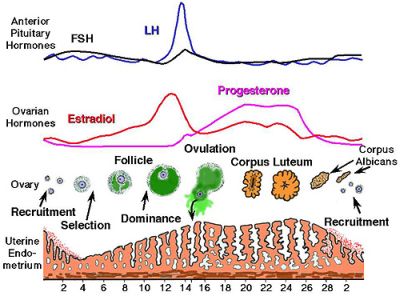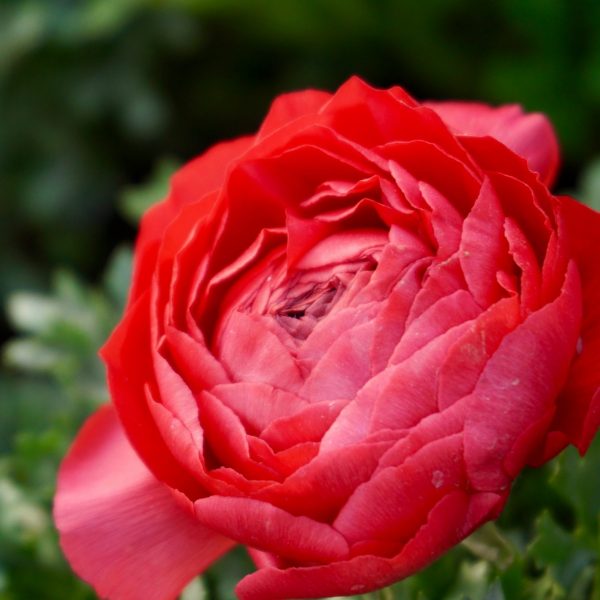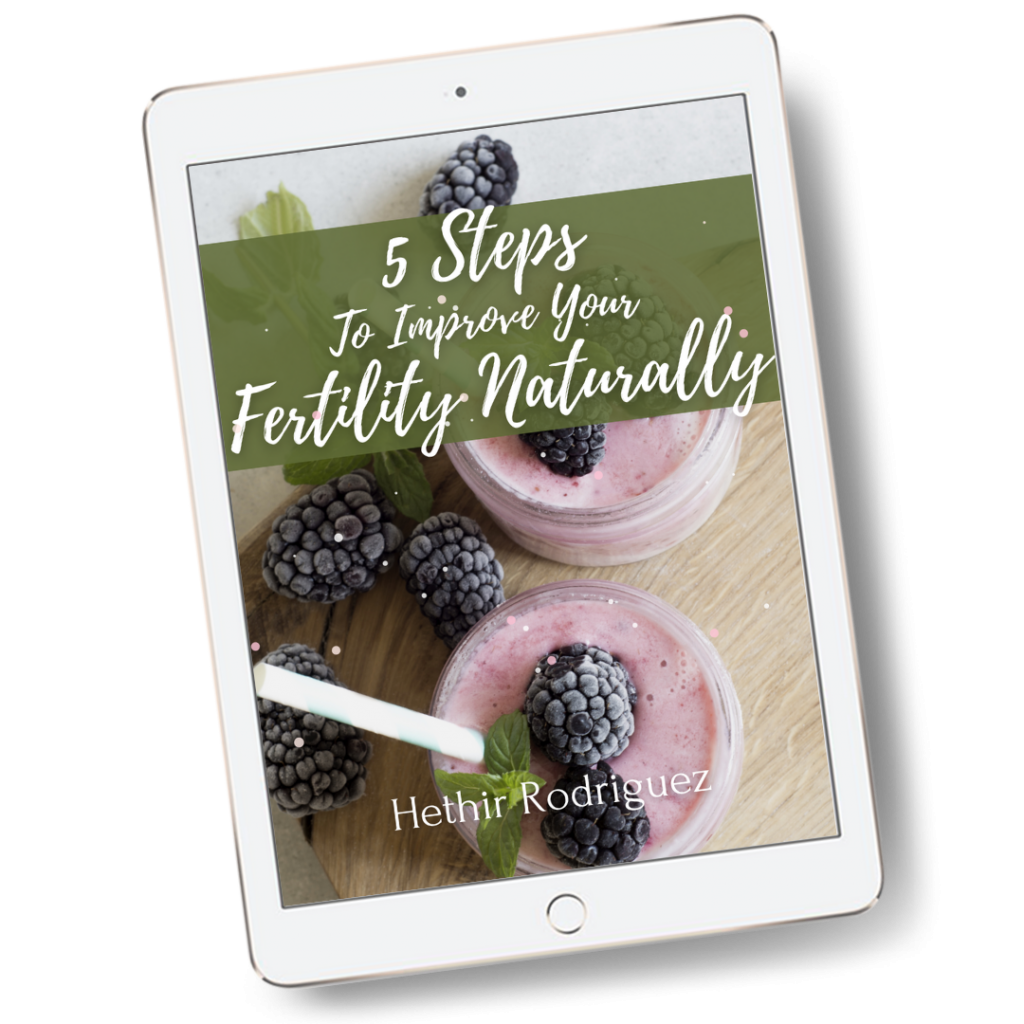Having a healthy menstrual cycle is instrumental to having abundant fertility. The menstrual cycle can tell us a lot about what is happening in the body- if the uterus is getting enough circulation, if hormones are imbalanced, if you are ovulating and so much more. In this article we will cover the different phases of the menstrual cycle, how to use different signs of the menstrual cycle to determine your health, and how to use natural therapies such as fertility cleansing, herbs, and a natural fertility diet to help support and maintain a healthy cycle.
Also, determining what is ‘normal’ or what should be the goal for us to get our cycles back on track is equally as important. While everyone cannot fit into one box, there is a general range that represents a healthy cycle. But let’s start from the beginning…
What is a period?
Menstruation (the period) is the shedding of the endometrial lining of the uterus. This generally occurs monthly, releasing blood and tissues from the uterus through the vagina.
Note: There are many resources and texts explaining menarche through menopause, including menstruation and other natural processes of the female body. One of them is Women, Hormones and The Menstrual Cycle – herbal and medical solutions from adolescence to menopause by Ruth Trickey. In an online resource, Dr.s Jennifer Knudtson and Jessica E. McLaughlin of the University of Texas Health and Science Center at San Antonio explain the female process of menstruation in great detail for the world’s most widely used professional and patient-centered medical information resource, Merck Manuals, the resource in linked in the references below. Let me try to simplify it for you though…
How the cycle works…

The period is only one part of the amazingly complex monthly fertility cycle orchestrated by the endocrine system. The endocrine glands work together to send messages via hormones. This is called the feedback loop.
In very simple terms, the hypothalamus produces GnRH (gonadotrophin-releasing hormones) which signals the pituitary to produce LH (luteinizing hormones) and FSH (follicle stimulating hormone) to send a signal to the ovaries that it is their turn to release estrogen and progesterone which is recognized by the pituitary gland.
Simple right? Not so. As you can see a healthy cycle is dependent on each part of the feedback loop and whether it is functioning properly. Think of it as an orchestra, if just one part of the cycle is off, it will throw the entire cycle off, causing imbalances that can affect fertility.
Phases of the menstrual cycle
Follicular phase
The hypothalamus responds to the different levels of estrogen and progesterone secreted from the ovaries. When estrogen drops during the period, the hypothalamus secretes GnRH which signals to the pituitary to release FSH which then initiates the follicular growth in the ovary. 10-20 follicles will begin to develop, but only one of these will mature to become an egg. While they are developing, the follicles are producing estrogen, which stimulates the endometrium to develop in the uterus (the uterine lining in preparation for the implantation of a fertilized egg).
As the estrogen increases (secreted from the developing follicles prior to ovulation), the cervical mucus begins to change to ‘fertile mucus’ which is like an egg white in its consistency. The increasing levels of estrogen then trigger the secretion of GnRH from the hypothalamus which then signals the surge of LH and FSH, which normally triggers the release of the egg. Once ovulation occurs, FSH levels and LH drop quickly.
Luteal Phase
Ovulation is followed by the luteal phase. With LH present, the corpus luteum begins to secrete increasing quantities of progesterone and fairly constant levels of estrogen.
The endometrium is now influenced by progesterone causing it to develop to be capable of nourishing a developing embryo.
If fertilization does not occur, the decline of the hormones causes the endometrium to shed, which is dependent on hormones at all times for its health, maintenance and development. When estrogen reaches a low enough point, the hypothalamus releases GnRH and the cycle starts over again.
Counting the days of your menstrual cycle
Day one of the menstrual cycle is always the first day of your period. If you spot before your period has come, that is not counted. The days between the first day of your period and ovulation is called the ‘follicular phase’. Generally, this is 14 days long, but varies woman to woman. When ovulation occurs, the luteal phase begins.
The luteal phase is the days between ovulation and menstruation. It is generally 14 days long. This is the time when a fertilized egg is attaching itself to the lining in the uterus to establish itself. If the luteal phase is too short (less than 12 days), this can make implantation almost impossible as the egg has not had sufficient time to properly implant and signal to the cycle that pregnancy has occurred.
I find using a tool such as CycleBeads or fertility charting can be helpful in keeping track of your cycle so you can know the length and generally when ovulation will occur.
What is a normal period?
We get asked often what is an ideal period. Unfortunately, there is no one answer to this question as we are all different. A ‘textbook’ menstrual cycle is 28 days long with menstruation lasting 3-5 days. The information that is most important about your cycle is the length of your period, the length of your entire cycle, the amount of pain, and the color and consistency of the menstruation. We can use this information to learn how to best use herbs and natural therapies to help create a healthy, balanced cycle.
Length of a Healthy Cycle
The usual range of a healthy cycle is between 21 and 35 days. Some women will have cycles that are very different from this, but as long as there is a pattern, regularity, and a healthy body and the follicular phase is between 12-14 days in length, there should be no cause for concern.
Hormone levels and ovulation create the regularity of your cycle. Failure to ovulate will affect hormonal levels and hormonal imbalance will affect/inhibit the secretion of hormones that stimulate ovulation.
There are many factors that can affect hormonal balance and ovulation, stress being one of them.
How to use the signs of your menstrual cycle to determine your hormonal balance
Below is a list of associations and is not in any way intended as a diagnostic tool. My goal is to help you read your body and listen when it is telling you something is out of balance. The menstrual cycle is one of the best ways the body communicates about your fertility. The details of your menstrual cycle can be used as a window into your fertility, telling you just what is going on, where an imbalance may lie, how your reproductive circulation is and if there is a hormonal imbalance.
Missing a period
Missing one period is no cause for alarm. Hormonal balance is very delicate and can be affected easily by stress. It generally will reset itself. Missing one or a couple of periods does not imply infertility necessarily as you can still ovulate even if you are not menstruating. This happened to a friend of mine and she became pregnant. Missing a period for 6 months or more is called amenorrhea and is covered below and here in this guide…
Short Cycles
Short cycles can cause fertility issues due to lack of ovulation, too short of a follicular or luteal phase, lack of nutrition, deficiencies, anemia or low body weight. One of the best herbs that has been used for luteal phase defect is vitex. In studies, vitex helped 83% of women experiencing luteal phase defect.
Longer Periods
A longer period may be an indication of hormonal imbalance and/or a failure to ovulate. Progesterone secreted by the body after ovulation normally helps to stop excess bleeding because of its effect on preserving the uterine lining. If estrogen is high or progesterone low, bleeding may continue longer than usual. Some herbal therapies that have been traditionally used for balancing longer periods are vitex and Slow Flow.
Heavy menstruation
This is known to be caused by a progesterone imbalance and/or over-stimulation of the uterine lining from estrogens (estrogen dominance). Traditionally this imbalance can be helped by:
- Supporting the liver in excreting excess estrogen
- Modifying the diet and utilizing medicinal herbs to help regulate progesterone and hormonal balance
Nutritional imbalances have also been linked to prolonged or heavy bleeding. Vitamin A deficiency may be a contributing factor in heavy menstruation. Studies have shown vitamin A intake to significantly decrease the amount of blood and the duration of the menses.
Another important vitamin, vitamin C, has been shown to help reduce heavy bleeding by strengthening the capillaries, helping to reduce their fragility. One study reported an 87% success rate in reducing heavy bleeding with vitamin C.
Slow Flow is the best herbal-supplement blend I have seen to help with heavy menstruation. It contains herbs that are astringent (helping to slow blood flow) and nutrients such as vitamin A, C and K. In addition, vitex and liver supporting herbs have been found to be helpful.
Light menstruation with strong cramping
Generally, the cramping could be helped by using herbs that have an anti-spasmodic, calming effect on the uterus. If there is light, bright red menstruation, this may also be a sign of a lack of circulation to the uterus (called a ‘cold uterus’ in Traditional Chinese Medicine). This may be helped by these herbs and natural therapies:
- Crampbark or Black Haw
- Dong quai
- Self Fertility Massage
- Castor Oil packs
- Heating packs
- UteriCalm
Bright Red Blood
Generally bright red blood indicates a healthy period. Rejoice!
Dark, brown or thick blood
Thick dark blood that looks old or is brown is old blood left over from the previous cycle. This may be caused by a sluggish menstrual flow, lack of uterine tone or low uterine circulation. Herbs and therapies used traditionally for this imbalance are:
- Self Fertility Massage
- Cleansing for Fertility
- Systemic Enzyme Therapy
- Hydration
- FertiliCare Phase 1 & 2
Pale Blood, Watery or thin menstruation
Pale pink, thin blood traditionally signifies poor blood quality which can be enriched by using blood building herbs, hormone balancing, and increasing circulation. Eating a healthy diet will also be beneficial.
- Blood Builder
- Dong Quai
- Self Fertility Massage
- FertiliCare Phase 1 & 2
Clots
As viewed from a holistic perspective, menstrual clots are seen as a sign of stagnation created from excessive flow that is not being expelled. Herbs and therapies that are beneficial for increasing uterine tone are:
Spotting and bleeding between periods
Spotting is a tricky subject as it can be caused by many different factors. Most times it is not something to be concerned about. Some of the causes may be:
- Disturbance in hormone balance – feedback loop
- Failure to ovulate
- Endometriosis
- Abnormalities of the cervix
- Ovarian cysts
- Ovulation has occurred – some women experience spotting during ovulation due to the estrogen changes mid-cycle.
- Hormonal contraceptives
- Excessive exercise
- Poor nutrition
No period (amenorrhea)
It can be quite frustrating if you are trying to get pregnant and yet have no period. Having a healthy cycle is step one for boosting your fertility naturally and being able to get pregnant. There are a couple of reasons a menstrual cycle may be irregular in women in their reproductive years such as stress, dietary deficiencies, low body weight, getting off of birth control pills, hormonal imbalance, perimenopause (the phase leading up to menopause), or other underlying health issues.
Since the lining of the uterus is not being shed, it is very important to clear out the old blood and establish a healthy cycle again. This can be done naturally and effectively with herbs and nutrition. I have talked with many clients who have been offered synthetic estrogen to get their periods going again… taking synthetic estrogen for this issue is like using a sledge hammer on a thumb tack.
Natural therapies such as the liquid herbal blend RejuvaFlow, fertility cleansing, Dong Quai, Fem Rebalance or Vitex have been found helpful.
It is very normal for women who are in perimenopause to experience sporadic cycles. Perimenopause is the time leading up to menopause. As perimenopause progresses toward menopause, it is normal for menstrual cycles to become irregular, or absent due to hormone levels fluctuating. As ovarian reserve diminishes and egg health declines, hormone levels change preparing the body for menopause. This is completely normal. A woman who has not had a menstrual cycle for a year or more and is between the ages of 40-55 is considered to be menopausal. Learn more about this here…
Steps to maintaining a healthy cycle
Depending on each situation, the herbs and therapies may be different. In addition to a specific herbal, supplemental, and therapeutic protocol, here are 4 steps every woman can take to promote a healthy menstrual cycle.
1. Hormonal Balance
Promoting hormonal balance with the use of nourishing herbs and supplements. As you have read, there is a delicate balance between hormonal balance and imbalance. In some cases, the endocrine system may need some nourishment and support. There are herbs and supplements that are specific for this (see list further down). Diet is also very important for hormonal balance.
In addition, the 3 other steps below also help to support hormonal balance.
2. Liver Health
The liver helps to filter toxins from the body including excess hormones. If there is an overabundance of estrogen, the liver will be overloaded and in need of a little herbal help. Doing a Fertility Cleanse or using liver cleansing herbs such as Milk Thistle, can help to continually support the liver in detoxification. I personally am constantly using herbs and juices to help support the liver to cleanse itself as our modern world can be so toxic.
3. Nutrition and hydration
Nutrition plays a big role in a healthy menstrual cycle and hormonal balance. It is important for us to consume a wide variety of minerals, vitamins, essential fatty acids and antioxidants. Some of the nutrients that are specific to hormonal balance (remember a healthy diet is VERY important, not just getting these singled-out nutrients) can be found in a whole food multivitamin.
- Iron
- Beta-carotene/Vitamin A
- B12
- omega 3 fatty acid
- vitamin D
You can learn more about eating a diet specific for fertility here…
Hydration is also important. In many cases of stagnation (such as blood clots or dark menstrual blood) dehydration is a contributing factor. In order for the menstruation to FLOW from us, it needs to have a liquid consistency and not a sticky, thick consistency.
Drinking plenty of water and fresh-squeezed juices is important for a healthy flow. Starting your day with a quart of water (with lemon if you like) is a great idea. Make sure to get another quart throughout the day. In addition, add at least 1 quart of fresh juiced vegetable and fruit juices and you are on your way to abundant health.
4. Stress reduction
Stress can have an impact on your menstrual cycle. Traveling, work stress, family stress, stress about infertility, financial stress can have an impact on the hormones that are released.
Stress boosts levels of stress hormones such as cortisol, which inhibits the body’s main sex hormones GnRH (gonadotropin releasing hormone) and subsequently may suppress ovulation, sexual activity and sperm count.
Supporting the adrenal gland is also helpful for hormonal balance as it can get burned out from too much stress for too long and can negatively affect the endocrine system.
There are many ways to begin to reduce the amount of stress and alter your reaction to stress such as:
- Meditation
- Mind/Body programs such as Circle Bloom
- Use EFT to help reduce anxiety and stress around fertility
- Exercise can also help to release stress
Herbal Formulas for Menstrual Health
FertiliCare Phase 1 & 2
FertiliCare Phase 1 & 2 Monthly Program is a liquid herbal program designed to support general reproductive health throughout your monthly fertility cycle. Utilizing two organic herbal formulas, one for the first half of your cycle and another for the second half, you are able to support your body’s natural fertility cycle with specific herbal formulas for each phase.
FertiliCare Phase 1 supports the first half of the cycle from menstruation through ovulation (day 14 average). FertiliCare Phase 1 helps to support:
- Normal ovulation*
- Balanced hormone production*
- Healthy uterine lining in preparation for implantation*
FertiliCare Phase 2 supports the second half of the cycle from right after ovulation until menstruation begins (day 15 until your period begins). FertiliCare Phase 2 helps to support:
- Normal progesterone production.*
- Circulation to the reproductive system.*
- Calming the uterus to support implantation.*
- The hormonal system.*
Dong Quai
Dong Quai (Angelica sinensis) works by promoting blood flow to the pelvis where it will stimulate an absent or scanty period. It also nourishes the blood (it is in nearly all Chinese herbal blood-building formulas). Dong Quai helps with iron deficiency and anemia. One of the best uses is it helps women who are not menstruating to invite their menstruation back. The increased circulation also helps to strengthen and balance the uterus.
Herbalist Roy Upton shares of therapeutic use of Dong Quai root for pain management, circulation promotion, and both stimulation and relaxation of the uterus (and much more) in his 2003 report in the American Herbal Pharmacopoeia and Therapeutic Compendium. Dong quai has been used by herbal practitioners for thousands of years to help build the lining of the uterus.
Slow Flow
Slow Flow is an herbal and nutritional supplement blend designed to promote normal menses.* This formula contains astringent herbs and nutrients which are to be used on heavy bleeding days.
Fem Rebalance
Fem Rebalance is a unique blend of herbs traditionally used to restore and re-balance a woman’s internal hormonal state. Hormonal balance may need restoring after discontinuing oral contraceptives or hormone replacement therapy, during stress, or weight loss.
Vitex
Vitex (Vitex agnus-castus) is an incredible hormone balancer, which adapts to women’s different needs. Vitex has been shown to normalize heavy menstrual bleeding (menorrhagia), relieve amenorrhea (absent menstrual cycle), and decrease polymenorrhea (too frequent periods). Vitex even eases inflammation of the uterus or ovaries, so it’s a good choice for women prone to painful fibroids or cysts, too.
Blood Builder
Iron is an essential mineral found in both vegetable and animal-based foods. In iron-rich foods, the mineral iron is found with other beneficial nutrients such as B12, folic acid, and vitamin C, which are all important for iron absorption. These important nutrients have been included in Blood Builder, helping to increase absorption and utilization of iron in the body. Blood Builder is an easy way to supplement your diet with a whole food iron that is easily absorbed and utilized by the body. Plus, this formula is non-constipating and easy to digest!
Maca
Maca (Lepidium meyenii) is a nourishing food for the endocrine system, aiding both the pituitary, adrenal, and thyroid glands (all involved in hormonal balance.) Maca has the ability to affect key hormones in both women and men without containing hormones itself.
Maca helps to stimulate and nourish the pituitary gland, acting as a tonic for the hormone system. When the pituitary gland functions optimally, the entire endocrine system becomes balanced, because the pituitary gland controls the hormone output of the other three glands.
EFA’s
The hypothalamus is fed by essential fatty acids (EFA’s) and other nutrients. The glandular system utilizes essential fatty acids to produce hormones. If you are deficient, the body doesn’t have the building blocks to make the proper hormones. A sign that you may not have enough EFA’s in your system is dry skin and hair.
Harmonize Formula
Harmonize Formula is a liquid herbal extract designed to encourage a healthy monthly fertility cycle that may have been missing due to long term hormone imbalance. This blend contains 6 organic herbs known to support and guide the body’s natural hormone and ovulation cycle and to alleviate common discomforts associated with PCOS.
- Trickey, Ruth. (2003). Women, Hormones and The Menstrual Cycle – herbal and medical solutions from adolescence to menopause. Crows nest, NSW: Allen & Unwin.
- Knudtson, J. and McLaughin, J.E. (full review/revision August 2016). Female Reproductive Endocrinology. Merck Manual. Retrieved from https://www.merckmanuals.com/professional/gynecology-and-obstetrics/female-reproductive-endocrinology/female-reproductive-endocrinology
- Lithgow, D. M., & Politzer, W. M. (1977). Vitamin A in the treatment of menorrhagia. S Afr Med J, 51(7), 191-193. Retrieved from: https://www.ncbi.nlm.nih.gov/pubmed/847567
- Cohen, J. D., & Rubin, H. W. (1960). Functional menorrhagia: treatment with bioflavonoids and vitamin C. Current therapeutic research, clinical and experimental, 2, 539. Retrieved from: https://www.ncbi.nlm.nih.gov/pubmed/13694387
- Hobbs Christopher. (2003). Vitex The Women’s Herb. Summertown, Tennessee: Healthy Living Publications.
- Upton R. (2003). Dang Gui Root; Angelica sinensis (Oliv.) Diels Standards of Analysis, Quality Control, and Therapeutics. American Herbal Pharmacopoeia and Therapeutic Compendium. Retrieved from https://achs.edu/course_pdfs/herb503_ahp_dang_gui.pdf
- Hudson, Tori N.D. (2008). Women’s Encyclopedia of Natural Medicine – Alternative Therapies and Integrative Medicine for Total Health and Wellness. Revised and Updated. New York: McGraw Hill.
- Romm, Aviva. (2010). Botanical Medicine for Women’s Health. St. Louis, Missouri: Churchill Livingstone Press.





